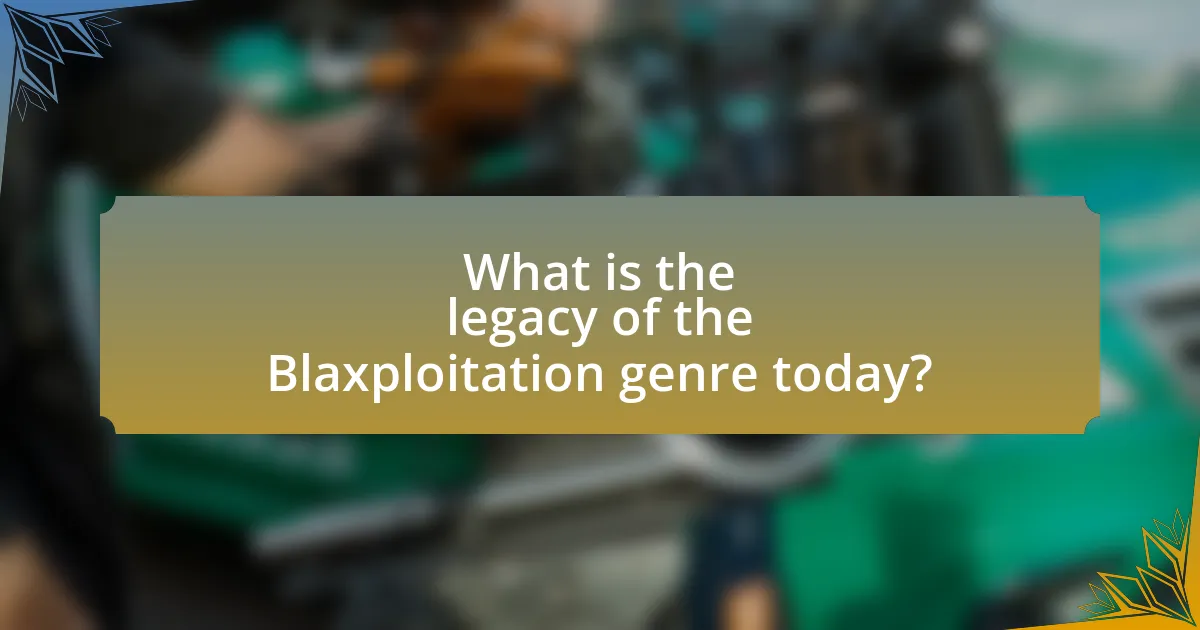The Blaxploitation genre is a significant film movement that emerged in the early 1970s in the United States, characterized by its focus on African American culture and the portrayal of Black protagonists in leading roles. This genre arose as a response to the lack of representation in mainstream cinema, influenced by the civil rights movement and the demand for authentic narratives reflecting the African American experience. Key filmmakers and actors, such as Gordon Parks and Pam Grier, played pivotal roles in shaping the genre, which is marked by its unique stylistic elements, themes of empowerment, and social commentary. The impact of Blaxploitation films on American culture and the film industry is profound, leading to increased representation of Black stories and characters, while also sparking debates about authenticity and exploitation within the genre. Today, the legacy of Blaxploitation continues to influence contemporary cinema, highlighting the importance of diversity and representation in film.

What is the Blaxploitation Genre?
The Blaxploitation genre is a film genre that emerged in the United States during the early 1970s, characterized by its focus on African American culture and its portrayal of Black protagonists in leading roles. This genre was significant for its representation of Black characters and stories, often set in urban environments, and it aimed to appeal to Black audiences while also attracting mainstream viewers. Notable films in this genre include “Shaft” (1971) and “Super Fly” (1972), which not only achieved commercial success but also influenced the portrayal of African Americans in cinema. The genre is recognized for its impact on both the film industry and cultural perceptions of race, contributing to discussions about identity, empowerment, and social issues within the African American community.
How did the Blaxploitation genre emerge in American cinema?
The Blaxploitation genre emerged in American cinema during the early 1970s as a response to the lack of representation of African Americans in film. This genre was characterized by its focus on Black protagonists, urban settings, and themes relevant to the African American experience, often featuring elements of crime, action, and social commentary. The emergence was fueled by the civil rights movement, which heightened awareness of racial issues and created a demand for films that reflected the realities and aspirations of Black audiences. Notable films such as “Sweet Sweetback’s Baadasssss Song” (1971) by Melvin Van Peebles and “Shaft” (1971) by Gordon Parks played pivotal roles in establishing the genre, showcasing Black characters in empowered roles and achieving commercial success. The genre’s popularity led to a significant shift in Hollywood, prompting studios to produce more films aimed at Black audiences, thereby influencing the cultural landscape of American cinema.
What historical and social factors contributed to the rise of Blaxploitation films?
The rise of Blaxploitation films was primarily driven by the social and political climate of the 1960s and 1970s, particularly the civil rights movement and the demand for representation of African Americans in media. The civil rights movement, which sought to end racial discrimination and promote equality, created a cultural backdrop that encouraged filmmakers to explore Black narratives and experiences. Additionally, the economic downturn in Hollywood led to a search for new audiences, prompting studios to capitalize on the growing Black consumer market. The success of films like “Sweet Sweetback’s Baadasssss Song” in 1971 demonstrated the commercial viability of Black-led stories, further solidifying the genre’s popularity. This combination of social activism and economic opportunity resulted in a significant increase in the production of Blaxploitation films, which often featured strong Black protagonists and addressed issues of race, identity, and empowerment.
Who were the key filmmakers and actors involved in the Blaxploitation movement?
The key filmmakers involved in the Blaxploitation movement include Gordon Parks, who directed “Shaft” in 1971, and Melvin Van Peebles, known for “Sweet Sweetback’s Baadasssss Song” released in 1971. Prominent actors include Richard Roundtree, who starred as John Shaft, and Pam Grier, recognized for her roles in films like “Foxy Brown” and “Coffy.” These filmmakers and actors played crucial roles in shaping the genre, which emerged in the early 1970s and focused on African American culture and experiences, often featuring strong Black protagonists and addressing social issues. The movement significantly influenced Hollywood and popular culture, leading to a greater representation of Black stories in cinema.
What are the defining characteristics of Blaxploitation films?
Blaxploitation films are characterized by their focus on African American culture, often featuring Black protagonists in leading roles, and addressing social issues such as racism and poverty. These films emerged in the early 1970s, with notable examples including “Shaft” and “Super Fly,” which showcased strong, independent Black characters and utilized a distinctive style that combined elements of action, drama, and music. The genre also employed a unique soundtrack, often featuring funk and soul music, which contributed to its cultural resonance. Additionally, Blaxploitation films frequently included themes of empowerment and resistance against systemic oppression, reflecting the socio-political climate of the time, particularly the Civil Rights Movement.
How do themes of race and identity manifest in Blaxploitation cinema?
Themes of race and identity in Blaxploitation cinema manifest through the portrayal of African American characters as empowered protagonists who challenge systemic racism and societal stereotypes. These films, emerging in the early 1970s, often depict Black individuals in roles of strength and agency, contrasting with the historically marginalized representations in mainstream cinema. For instance, films like “Shaft” and “Super Fly” feature Black heroes who navigate urban environments, confront oppression, and assert their identity, reflecting a growing sense of racial pride during the Civil Rights Movement. The genre also critiques social issues such as police brutality and economic inequality, thereby reinforcing the importance of race and identity in shaping the narratives and experiences of African Americans.
What stylistic elements are commonly found in Blaxploitation films?
Blaxploitation films commonly feature stylistic elements such as funk music, exaggerated characters, and urban settings. Funk music, characterized by its rhythmic grooves and brass instrumentation, serves as a defining soundtrack, enhancing the films’ cultural resonance and appeal. Exaggerated characters often embody stereotypes, such as the tough hero or the seductive femme fatale, which reflect societal attitudes and contribute to the genre’s unique narrative style. Urban settings, typically depicting inner-city life, provide a backdrop that emphasizes the struggles and triumphs of African American communities during the 1970s. These elements collectively create a distinctive aesthetic that has influenced subsequent film genres and cultural expressions.
What impact did the Blaxploitation genre have on American culture?
The Blaxploitation genre significantly impacted American culture by providing a platform for African American filmmakers and actors, thereby reshaping the representation of Black individuals in cinema. This genre emerged in the early 1970s, with films like “Shaft” and “Super Fly” showcasing Black protagonists in leading roles, which was a departure from the stereotypical portrayals common in earlier Hollywood films. The genre not only highlighted issues of race and social justice but also influenced music, fashion, and language, contributing to the broader cultural movements of the time, such as the Civil Rights Movement. The success of Blaxploitation films demonstrated the commercial viability of Black-centered narratives, leading to increased opportunities for Black artists in the film industry and fostering a sense of pride and identity within the African American community.
How did Blaxploitation films influence perceptions of African Americans in media?
Blaxploitation films significantly influenced perceptions of African Americans in media by portraying them as empowered protagonists in a genre that challenged existing stereotypes. These films, emerging in the early 1970s, featured African American characters in leading roles, often as heroes who fought against systemic oppression and societal injustices. For instance, films like “Shaft” and “Super Fly” showcased African American culture, style, and resilience, which contrasted sharply with the negative depictions prevalent in earlier Hollywood productions. This shift not only provided a platform for African American filmmakers and actors but also contributed to a broader cultural recognition of African American identity and issues. The genre’s impact is evidenced by its lasting influence on subsequent media representations, as it opened doors for more nuanced and diverse portrayals of African Americans in film and television.
What role did music play in shaping the cultural significance of Blaxploitation films?
Music played a crucial role in shaping the cultural significance of Blaxploitation films by providing a distinctive sound that resonated with African American audiences and reflected their experiences. The incorporation of funk, soul, and jazz music not only enhanced the films’ narratives but also established a cultural identity that celebrated Black empowerment and resistance. For instance, soundtracks from films like “Super Fly,” featuring Curtis Mayfield, became iconic, influencing both the film’s popularity and the broader cultural landscape of the 1970s. This synergy between music and film helped to elevate the genre, making it a vehicle for social commentary and cultural expression, thus solidifying its legacy in American cinema.

How did Blaxploitation films shape the film industry?
Blaxploitation films significantly shaped the film industry by introducing African American narratives and characters into mainstream cinema, thereby challenging racial stereotypes. These films emerged in the early 1970s, with titles like “Shaft” and “Super Fly,” which not only showcased Black talent both in front of and behind the camera but also catered to urban audiences, leading to a new genre that combined social commentary with entertainment. The success of Blaxploitation films demonstrated the commercial viability of Black stories, prompting Hollywood to invest more in diverse narratives and talent. This shift contributed to the gradual diversification of film content and paved the way for future filmmakers of color, influencing genres and storytelling approaches in subsequent decades.
What changes did Blaxploitation bring to Hollywood filmmaking practices?
Blaxploitation introduced significant changes to Hollywood filmmaking practices by prioritizing African American narratives and characters, which had been largely marginalized. This genre led to the incorporation of more diverse storytelling, showcasing the experiences and culture of Black communities, and it encouraged the hiring of Black directors, writers, and actors, such as Gordon Parks and Pam Grier. The success of films like “Sweet Sweetback’s Baadasssss Song” (1971) demonstrated the commercial viability of Black-led films, prompting studios to invest in similar projects. Additionally, Blaxploitation films often featured soundtracks that highlighted funk and soul music, influencing the overall aesthetic and marketing strategies of Hollywood productions. This shift not only expanded the representation of Black culture in mainstream cinema but also altered the industry’s approach to genre filmmaking, leading to a broader acceptance of diverse voices in storytelling.
How did the success of Blaxploitation films affect the representation of African Americans in mainstream cinema?
The success of Blaxploitation films significantly altered the representation of African Americans in mainstream cinema by introducing complex, empowered characters and addressing social issues relevant to the Black community. These films, which emerged in the early 1970s, showcased African American actors in leading roles, often portraying them as heroes or anti-heroes, which contrasted sharply with the stereotypical roles that had previously dominated Hollywood. For instance, films like “Shaft” and “Super Fly” not only achieved commercial success but also highlighted themes of racial identity, empowerment, and resistance against systemic oppression. This shift prompted Hollywood to recognize the profitability of Black narratives, leading to increased opportunities for African American filmmakers and actors in subsequent decades. The impact of Blaxploitation films can be seen in the later emergence of more diverse storytelling and character representation in mainstream cinema, paving the way for films that explore the complexities of African American experiences beyond stereotypes.
What lessons did Hollywood learn from the Blaxploitation era?
Hollywood learned the importance of authentic representation and the commercial viability of Black narratives from the Blaxploitation era. This genre, which emerged in the early 1970s, showcased Black protagonists and addressed social issues relevant to the African American community, leading to significant box office success. Films like “Shaft” and “Super Fly” demonstrated that audiences were eager for stories that reflected their experiences, prompting Hollywood to diversify its storytelling and casting practices. The era also highlighted the necessity of involving Black creatives in the filmmaking process, which has influenced contemporary practices in the industry, leading to a greater emphasis on authenticity and cultural sensitivity in film production.
What controversies surrounded the Blaxploitation genre?
The Blaxploitation genre faced controversies primarily due to its portrayal of African Americans, which some critics argued perpetuated negative stereotypes. Films like “Super Fly” and “Shaft” often depicted characters involved in crime, drugs, and violence, leading to accusations that the genre reinforced harmful societal views. Additionally, there was debate over the authenticity of the narratives, as many films were produced by white filmmakers, raising concerns about cultural appropriation and exploitation. The genre also sparked discussions about the representation of Black culture in mainstream media, with some praising its empowerment of Black voices while others criticized it for commercializing Black struggles.
How did critics respond to the portrayal of African Americans in Blaxploitation films?
Critics responded to the portrayal of African Americans in Blaxploitation films with a mix of praise and criticism. Some praised the genre for providing African American actors with leading roles and showcasing black culture, which was often absent in mainstream cinema. For instance, films like “Shaft” and “Super Fly” highlighted black empowerment and challenged racial stereotypes. However, many critics condemned these films for perpetuating negative stereotypes, such as criminality and hypersexuality, arguing that they reinforced harmful societal views rather than dismantling them. Notably, scholar Mark A. Reid in his book “Blaxploitation Cinema: The Essential Reference Guide” discusses how the genre’s duality reflects both a celebration of black identity and a troubling reinforcement of stereotypes.
What debates arose regarding the authenticity and exploitation within the genre?
Debates regarding authenticity and exploitation within the Blaxploitation genre center on the portrayal of African American culture and the commercial motivations behind the films. Critics argue that while the genre provided a platform for Black filmmakers and actors, it often perpetuated stereotypes and exploited racial identity for profit. For instance, films like “Sweet Sweetback’s Baadasssss Song” were celebrated for their groundbreaking representation, yet they also faced scrutiny for their sensationalism and reliance on negative tropes. This duality raises questions about whether the genre genuinely empowered Black voices or merely served as a vehicle for exploitation by predominantly white studio executives seeking financial gain.

What is the legacy of the Blaxploitation genre today?
The legacy of the Blaxploitation genre today is significant in shaping contemporary cinema and cultural representation. This genre, which emerged in the 1970s, provided a platform for African American filmmakers and actors, influencing the portrayal of Black characters in film. The genre’s impact is evident in modern films that incorporate themes of empowerment, social justice, and cultural identity, reflecting the struggles and triumphs of the Black community. For instance, films like “Black Panther” and “Get Out” draw inspiration from Blaxploitation’s bold storytelling and character development, showcasing the ongoing relevance of its themes. Additionally, the genre has sparked discussions about race, representation, and the commercialization of Black culture, leading to a more nuanced understanding of these issues in today’s media landscape.
How do contemporary filmmakers draw inspiration from Blaxploitation films?
Contemporary filmmakers draw inspiration from Blaxploitation films by incorporating their stylistic elements, themes of empowerment, and cultural commentary into modern narratives. For instance, films like “Black Panther” and “Dolemite Is My Name” reflect the bold aesthetics and social critiques characteristic of the Blaxploitation era, showcasing strong Black protagonists and addressing issues of race and identity. Additionally, the use of funk and soul music in soundtracks, a hallmark of Blaxploitation, has been revived in contemporary cinema to evoke nostalgia and cultural resonance. This connection is evident in the way filmmakers pay homage to the genre’s unique visual style and storytelling techniques, thereby reinforcing its lasting influence on the film industry.
What modern films or series reflect the influence of the Blaxploitation genre?
Modern films and series that reflect the influence of the Blaxploitation genre include “Black Panther,” “Dolemite Is My Name,” and “Luke Cage.” “Black Panther” incorporates elements of Blaxploitation through its celebration of Black culture and empowerment, while “Dolemite Is My Name” pays homage to the genre’s campy style and independent spirit, showcasing the life of Rudy Ray Moore, a key figure in Blaxploitation. Additionally, “Luke Cage” features a strong Black protagonist and draws on the genre’s themes of social justice and resilience, further solidifying its connection to Blaxploitation’s legacy.
How has the perception of Blaxploitation changed in recent years?
The perception of Blaxploitation has shifted significantly in recent years, evolving from a largely negative view to a more nuanced appreciation. Initially criticized for perpetuating stereotypes and exploiting Black culture, contemporary analysis recognizes the genre’s role in empowering Black filmmakers and actors, as well as its impact on the representation of African Americans in cinema. This change is supported by academic discussions and retrospectives that highlight films like “Sweet Sweetback’s Baadasssss Song” and “Shaft” as pioneering works that challenged mainstream narratives and provided a voice for marginalized communities. Additionally, the resurgence of interest in Blaxploitation films has been fueled by their influence on modern cinema, with filmmakers citing them as inspirations for contemporary storytelling and aesthetics.
What lessons can be learned from the Blaxploitation genre for future cinema?
The Blaxploitation genre teaches future cinema the importance of authentic representation and cultural specificity. This genre emerged in the early 1970s, showcasing Black characters and stories that resonated with African American audiences, which highlighted the demand for diverse narratives in mainstream media. Films like “Sweet Sweetback’s Baadasssss Song” and “Shaft” not only achieved commercial success but also influenced the portrayal of Black culture in cinema, demonstrating that audiences seek relatable and genuine stories. Furthermore, the genre’s blend of social commentary and entertainment illustrates the potential for films to address systemic issues while engaging viewers, a lesson that remains relevant for contemporary filmmakers aiming to create impactful cinema.
How can filmmakers today address issues of representation and diversity in their work?
Filmmakers today can address issues of representation and diversity by actively including diverse voices in the storytelling process and ensuring authentic representation of various cultures and identities. This can be achieved by hiring writers, directors, and actors from underrepresented backgrounds, which enhances the authenticity of the narratives being portrayed. For instance, the success of films like “Black Panther” demonstrates how inclusive casting and storytelling can resonate with a wide audience, leading to both critical acclaim and box office success. Additionally, filmmakers can engage in community outreach and collaboration with cultural consultants to accurately depict the experiences and perspectives of marginalized groups, thereby fostering a more inclusive film industry.
What best practices can be derived from the successes and failures of the Blaxploitation era?
Best practices derived from the successes and failures of the Blaxploitation era include prioritizing authentic representation and understanding audience demographics. Authentic representation is crucial, as films like “Sweet Sweetback’s Baadasssss Song” (1971) resonated with Black audiences by showcasing their experiences and culture, leading to commercial success. Conversely, the failure of films that relied on stereotypes, such as “The Black Gestapo” (1975), highlights the importance of avoiding harmful clichés. Additionally, leveraging grassroots marketing strategies, as seen with “Shaft” (1971), can effectively engage target audiences. Understanding the socio-political context of the time also informs content creation, as films that addressed contemporary issues, like racism and empowerment, garnered significant attention and impact.


